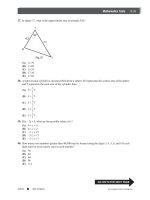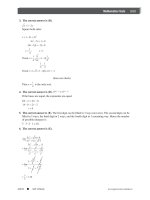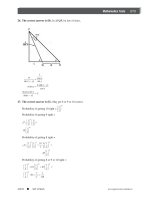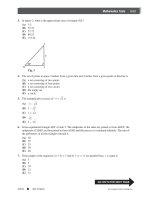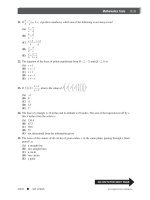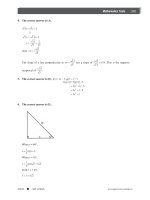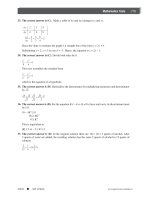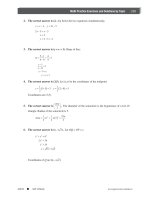SAT II History Episode 2 Part 8 ppsx
Bạn đang xem bản rút gọn của tài liệu. Xem và tải ngay bản đầy đủ của tài liệu tại đây (155.12 KB, 20 trang )
37. A forerunner of the Declaration of Indepen-
dence was
(A) the Proclamation of Rebellion
(B) Lee’s Resolution
(C) Suffolk Resolves
(D) Declaration of Rights and Grievances
(E) Olive Branch Petition
38. The Fourth Amendment grew out of the
colonists’ grievance against the British
practice of
(A) quartering troops at the expense of the
colonists
(B) writs of assistance
(C) strict libel laws
(D) courts of admiralty
(E) supporting the Church of England as the
established church
39. All of the following are true about the
Cherokee EXCEPT
(A) the Cherokee adopted farming and
converted to Christianity
(B) the Cherokee had a written constitution
and a form of government similar to that
of the United States
(C) Jackson sided with the Cherokee against
Georgia
(D) in Worcester v. Georgia, the Supreme
Court ruled in favor of the Cherokee
(E) the Cherokee supported the Confederacy
in the Civil War
40. Reduction of the tariff, restoration of the
independent treasury, settlement of the
Oregon boundary, and acquisition of Califor-
nia were the four goals of
(A) James K. Polk
(B) William Henry Harrison
(C) Henry Clay
(D) Daniel Webster
(E) Franklin Pierce
41. The Wilmot Proviso supported
(A) popular sovereignty to determine
whether a state created from the
Louisiana Territory would be free
or slave
(B) the argument of Southern senators that
Congress had no constitutional power to
forbid slavery in the territories
(C) a moratorium on the admission of any
new states to the Union until a perma-
nent solution would be found
(D) a ban on slavery in any state created out
of land acquired from Mexico
(E) a ban on the slave trade in Washington,
D.C.
42. Who wrote the influential muckraking book
History of the Standard Oil Company?
(A) Ray Stannard Baker
(B) Ida B.Wells
(C) Frank Norris
(D) Upton Sinclair
(E) Ida Tarbell
43. Which of the following was NOT a cause of
the U.S.’s declartion of war against Spain in
1898?
(A) The desire on the part of U.S. business
interests to protect their $50 million
investment in Cuba
(B) Americans’ desire to see the Cubans’ free
of Spanish rule
(C) The influence of yellow journalism
(D) The propaganda campaign waged by
Cubans in exile in the United States
(E) The explosion on board the USS Maine
➡
GO ON TO THE NEXT PAGE
PRACTICE TEST 3
PRACTICE TEST 3—Continued
315
Peterson’s n SAT II
Success: U.S. History www.petersons.com
44. In 1904, the Supreme Court ruled that which
of the following was a “combination in
restraint of trade”?
(A) Sherman Antitrust Act
(B) AFL
(C) Grange Movement
(D) Standard Oil Company
(E) Northern Securities Company
45. Which of the following was a U.S. program
that was meant to provide aid to poverty-
stricken countries anywhere in the world
fighting communism?
(A) Marshall Plan
(B) NATO
(C) Square Deal
(D) Point Four
(E) Alliance for Progress
46. By the mid-1700s, the largest city in the
colonies was
(A) New York
(B) Boston
(C) Philadelphia
(D) Charleston
(E) Wilmington, Delaware
47. All of the following were obstacles to
ratification of the Constitution EXCEPT
(A) lack of a Bill of Rights
(B) the federal structure established by the
Constitution placed the national govern-
ment over state governments
(C) Rhode Island’s boycott of the Constitu-
tional Convention
(D) ratification by a special convention in
each state rather than by the states’
legislatures
(E) lack of leadership among Federalists
48. The defeat of which Native American leader
made William Henry Harrison’s presidential
ambitions possible?
(A) The Prophet
(B) Tecumseh
(C) Cochise
(D) Chief Joseph
(E) Blue Jacket
49. Which of the following recommended that
the United States offer Spain $120 million for
Cuba and, if rejected, take the island by
force?
(A) Hay–Bunau-Varilla Treaty
(B) Ballinger-Pinchot Controversy
(C) Ostend Manifesto
(D) Gadsden Purchase
(E) Seward’s Folly
50. Organized labor would have supported
which of the following demands in the
“Omaha Platform” of the Populist Party in
the 1892 election?
(A) An increase in currency resulting from
the free and unlimited coinage of silver
(B) Government ownership of railroads
(C) 8-hour workday
(D) Graduated income tax
(E) Direct election of senators
SAT II SUCCESS: U.S. HISTORY
PRACTICE TEST 3—Continued
316
Peterson’s n SAT II
Success: U.S. Historywww.petersons.com
51. “This perennial rebirth, this fluidity of
American life, this expansion westward with
its new opportunities, its continuous touch
with the simplicity of primitive society,
furnish the forces dominating American
character. The true point of view in the
history of this nation is not the Atlantic
coast, it is the great West.”
The person who wrote this would most
likely NOT have agreed with
(A) the passage of the Pacific Railway Acts
(B) the Mexican War
(C) internal improvements bills
(D) the Gadsden Purchase
(E) the establishment of the Indian Territory
52. The major difference between W.E.B. Du
Bois and his fellow African Americans Booker
T. Washington and Marcus Garvey was Du
Bois’s
(A) appeal to the Talented Tenth
(B) belief that education alone would correct
all injustices
(C) disinterest in all things African
(D) focus on economic equality
(E) use of white politicians to gain an
audience for African American causes
53. The administration of Warren G. Harding was
most notable for
(A) pressing the Supreme Court to find
boycotts organized by labor to be legal
(B) supporting business interests
(C) passing the Fordney-McCumber Act,
which raised tariffs to an all-time high
(D) reducing the excess profits tax
(E) supporting McCarthyism
54. All of the following were accomplishments
of the New Deal EXCEPT the
(A) establishment of Social Security
(B) right of collective bargaining
(C) establishment of a program to fund
low-cost mortgages
(D) passage of a civil rights act
(E) funding of farm mortgages through the
Farm Credit Administration
55. During wartime conferences, the Allies
agreed to all of the following EXCEPT
(A) a combined U.S British invasion of
France
(B) Japan must agree to unconditional
surrender
(C) a nonbinding vote for permanent
members of the Security Council
(D) the Soviet Union’s entrance into the war
against Japan
(E) Stalin’s support for the Nationalist
Chinese
56. Which of the following third parties partici-
pated in the 1948 presidential election?
(A) Know-Nothing
(B) Communist
(C) Populist
(D) Dixiecrat
(E) Bull Moose
➡
GO ON TO THE NEXT PAGE
PRACTICE TEST 3
PRACTICE TEST 3—Continued
317
Peterson’s n SAT II
Success: U.S. History www.petersons.com
57. Which of the following presidents and
foreign policy initiatives are NOT correctly
paired?
(A) Lyndon Johnson: “two China” policy
(B) Harry Truman: Point Four Program
(C) Ronald Reagan: “Star Wars” antiballistic
missile system
(D) John F. Kennedy: Alliance for Progress
(E) Jimmy Carter: agreement to return the
Panama Canal Zone to Panama
58. Which statement best describes Richard
Nixon’s attitude toward Watergate?
(A) He did not believe that wiretapping the
Democratic National Headquarters and
trying to cover it up were serious
enough to be impeached over.
(B) He felt he was being unjustly prosecuted
by political adversaries in both parties.
(C) He did not believe that there was
anything wrong with wiretapping the
Democratic National Headquarters.
(D) He felt that Vice President Spiro Agnew
should have been impeached for his
role.
(E) He left office for the good of the country
while continuing to maintain his
innocence.
59. Over time, colonial Maryland developed an
economy very similar to that of
(A) Pennsylvania
(B) Virginia
(C) New Jersey
(D) Georgia
(E) Massachusetts
60. Even while the Revolutionary War was being
fought, it was clear that attitudes about a
number of things had changed. All of the
following are true about this period EXCEPT
(A) interest in extending civil and political
rights to women was apparent in New
England
(B) the hold of religion on people’s lives had
declined
(C) titles of nobility were eliminated by state
legislatures
(D) interest in abolishing slavery in some
areas of the nation was growing
(E) most new state constitutions called for a
strong legislative branch and a weak
executive
61. According to the Navigation Acts,
(A) goods did not have to be shipped
through England so long as customs
duties were paid
(B) enumerated goods could be sold only to
England
(C) hatmakers in the colonies could sell their
beaver hats to England or to the colonies
(D) colonists could export raw wool, yarn,
or wool cloth to countries other than
England if customs duties were paid
(E) smugglers would be tried in admiralty
courts
62. All of the following were provisions of the
Constitution as originally ratified EXCEPT
(A) indirect election of senators
(B) the counting of three fifths of slaves for
purposes of determining representation
in the House
(C) abolition of the internal slave trade
(D) enumerated powers
(E) the elastic clause
SAT II SUCCESS: U.S. HISTORY
PRACTICE TEST 3—Continued
318
Peterson’s n SAT II
Success: U.S. Historywww.petersons.com
63. Which of the following was NOT a cause of
the War of 1812?
(A) Macon’s Bill No. 2
(B) Westerners’ interest in seizing Canada
(C) Impressment of U.S. sailors
(D) U.S. attack on the Chesapeake
(E) British repeal of the Orders in Council
64. The underlying cause for the depression that
lingered after the Panic of 1837 was
(A) the high tariff
(B) cheap money
(C) overspeculation in Western lands
(D) a corresponding depression in European
markets
(E) Van Buren’s independent treasury system
65. Which of the following statements best
describes the purpose of the Fourteenth
Amendment?
(A) The Fourteenth Amendment overrode
the provision of Article I, counting
African Americans as three fifths of a
person for apportioning representatives
in the House.
(B) The federal government has used the
Civil War amendments to prosecute civil
rights cases in the twentieth century.
(C) The Fourteenth Amendment limits the
power of the federal government in
cases involving a citizen’s civil rights
within a state.
(D) The Fourteenth Amendment protects
citizens from acts of the states.
(E) Together, the Fourteenth and Seven-
teenth Amendments have extended the
franchise to all Americans of voting age.
66. Which of the following issues cost both
Hayes and Arthur their party’s renomination
as president?
(A) Tariff reform
(B) Cheap money
(C) Proposed regulation of big business
(D) Civil service reform
(E) Their use of federal troops to intervene
in strikes
➡
GO ON TO THE NEXT PAGE
PRACTICE TEST 3
PRACTICE TEST 3—Continued
319
Peterson’s n SAT II
Success: U.S. History www.petersons.com
Question 67 refers to the following photograph.
67. The photograph captures the significance of
the election of 1920 because it shows
(A) Harding running his “front porch”
campaign
(B) the absence of African Americans in the
crowd
(C) Harding running his “Rose Garden”
campaign
(D) the presence of women in the crowd
(E) the lack of enthusiasm from both
Harding and the crowd
SAT II SUCCESS: U.S. HISTORY
PRACTICE TEST 3—Continued
320
Peterson’s n SAT II
Success: U.S. Historywww.petersons.com
68. Which of the following agreements re-
nounced war as a vehicle of national policy?
(A) Five-Power Treaty
(B) Treaty of Versailles
(C) United Nations Charter
(D) Kellogg-Briand Pact
(E) Rush-Bagot Agreement
69. The War Powers Act of 1973 was passed in
response to Johnson’s use of his power as
commander in chief to send troops into
Vietnam. Which of the following presidents
also used his authority as commander in
chief to send troops to fight without asking
Congress’s approval?
(A) Harry Truman
(B) Franklin Roosevelt
(C) Dwight Eisenhower
(D) Woodrow Wilson
(E) Jimmy Carter
70. Critics of Reagan’s economic program
(A) complained that an increase in taxes
would damage economic growth
(B) advised “priming the pump”
(C) were supply-siders
(D) believed that he was passing the
problem of the huge federal deficit to
future generations
(E) urged a tax cut to jump-start the
economy
71. All of the following were associated with
colonial Pennsylvania EXCEPT
(A) Quakers
(B) theocratic government
(C) varied economy
(D) diverse population
(E) Lower Counties
72. Speaker I: The Constitution provides a
framework for what we should do and how
we should do it, but we—and future
generations—will need that elastic clause to
cover ideas we’ll never think of in 1794.
Speaker II: We are too weak as a nation and
too dependent on trade with Great Britain to
join the French—even if they did help us in
the Revolution.
Speaker III: We need some way to carry out
the financial powers listed in the Constitu-
tion, such as collecting taxes, but a national
bank is not the way to do it.
Which of the above statements is INCONSIS-
TENT with the Federalists’ position?
(A) I only
(B) I and II
(C) I and III
(D) II and III
(E) III only
73. All of the following are characteristics of
Transcendentalist thought and writing
EXCEPT
(A) the unity and divinity of nature and
humankind
(B) the use of nationalist themes and
symbols
(C) a belief in the importance of intuition
(D) an interest in mysticism
(E) belief in a Supreme Being
➡
GO ON TO THE NEXT PAGE
PRACTICE TEST 3
PRACTICE TEST 3—Continued
321
Peterson’s n SAT II
Success: U.S. History www.petersons.com
74. Which of the following reformers is INCOR-
RECTLY paired with his or her interest?
(A) Dorothea Dix: women’s suffrage
(B) Horace Mann: education
(C) Thomas Gallaudet: deaf and hearing
impaired
(D) Frederick Douglass: abolition
(E) Robert Owen: utopian society
75. The end of the excess profits tax in the
1920s was meant to
(A) help people continue buying on credit
by reducing interest rates
(B) stimulate investment by the wealthiest
members of society
(C) end the buying of stocks on margin
(D) “prime the pump”
(E) provide money for the average person to
begin setting aside a retirement fund
76. Which of the following statements is TRUE
about Franklin Roosevelt’s relations with the
Supreme Court?
(A) Once the so-called “court-packing
scheme” went through, Roosevelt named
so many justices that it became known
as the “Roosevelt Court.”
(B) Roosevelt was concerned that the
Supreme Court might overturn the Social
Security Act, so he asked Congress to
enlarge the number of judges in the
Circuit Court and justices on the
Supreme Court.
(C) The Supreme Court did less harm to his
programs than Roosevelt claimed.
(D) Roosevelt made the record of the
Supreme Court a campaign issue in
1936.
(E) The lower courts actually had more
impact on the New Deal than the
Supreme Court had, but Roosevelt was
determined to punish the higher court.
77. Since World War II, the trend in population
movement in the United States has been
(A) from the Rust Belt to the Sunbelt
(B) from all sections of the country to the
Sunbelt
(C) from the Northeast to the Southeast
(D) from the Snowbelt to the Sunbelt
(E) relatively stable
78. “I have always believed that, in order for a
movement to be lasting, it must be built on
the people Money by itself will not get
the job done Ifworkers are going to do
anything, they need their own power. They
need to involve themselves in meaningful
ways.”
All of the following would most likely agree
with these words EXCEPT
(A) César Chavez
(B) Herbert Spencer
(C) Samuel Gompers
(D) Eugene V. Debs
(E) Martin Luther King, Jr.
79. The significance of the Immigration Act of
1965 is that the Act
(A) abolished the national quota system for
immigration
(B) reinstated the elements of the Gentle-
men’s Agreement of 1906
(C) continued the system of preferences for
skilled workers and relatives of U.S.
citizens
(D) provided an amnesty under which
undocumented aliens could become legal
citizens
(E) made it easier for the INS to deport
illegal aliens
SAT II SUCCESS: U.S. HISTORY
PRACTICE TEST 3—Continued
322
Peterson’s n SAT II
Success: U.S. Historywww.petersons.com
80. Which of the following was the major
campaign issue in the 1992 election?
(A) the “Contract with America”
(B) health care
(C) the economy
(D) gun control
(E) aid to education
81. The writings of which of the following led to
the end of the encomienda system?
(A) King Ferdinand
(B) Fray Junípero Serra
(C) Hernán Cortés
(D) Bartolomé de Las Casas
(E) Fray Eusebio Kino
82. The major reason that slavery did not
develop in New England was
(A) the presence of natural resources more
suited to industrial development
(B) the presence of a large pool of native-
born women as workers
(C) Puritan teachings that opposed slavery
(D) its climate and land features were less
adaptable to large-scale farming
(E) that New England merchants did not
mind selling slaves but did not want to
be reminded by the presence of slaves
83. “Everything that is right or reasonable pleads
for separation. The blood of the slain, the
weeping voice of nature cries, ‘Tis Time to
Part!’ ”
The above statement, which deeply affected
the delegates to the Second Continental
Congress, is from
(A) Letters from a Farmer in Pennsylvania
by John Dickinson
(B) Poor Richard’s Almanack by Ben
Franklin
(C) Letters from an American Farmer by
Hector St. John de Crevécoeur
(D) Common Sense by Thomas Paine
(E) A letter from Abigail Adams
84. All of the following are examples of the
concept that third parties often develop out
of some radical approach to a problem
EXCEPT
(A) Populists
(B) Progressives
(C) Know-Nothings
(D) Democrats (Andrew Jackson era)
(E) Republicans (founded in 1854)
➡
GO ON TO THE NEXT PAGE
PRACTICE TEST 3
PRACTICE TEST 3—Continued
323
Peterson’s n SAT II
Success: U.S. History www.petersons.com
Question 85 refers to the following pie charts and table.
85. Which of the following statements best describes the significance of
the 1860 election data?
(A) Lincoln was a minority president.
(B) Douglas’s electoral percentage does not adequately reflect his
popularity.
(C) Voters did not vote by regional interest.
(D) While Douglas won the states with few electoral votes, he won
the majority of popular votes.
(E) The two Democratic candidates out- polled Lincoln in electoral
votes.
Percent Popular Vote
Bell
Constitutional Union Party
Breckinridge
Democrat (S)
Douglas
Democrat (N)
Lincoln
Republican
Electoral Vote
by State
Popular
Vote
Percent
Popular Vote
39
72
12
180
592,906
848,356
1,382,713
1,865,593
13%
18%
29.5%
39.5%
ELECTION OF 1860
13%
18%
29.5%
39.5%
Bell
Breckinridge Lincoln
Douglas
Percent Electoral Vote
13%
24%
4%
59%
SAT II SUCCESS: U.S. HISTORY
PRACTICE TEST 3—Continued
324
Peterson’s n SAT II
Success: U.S. Historywww.petersons.com
86. All of the following were among the reforms
inspired by progressives at the state and local
level EXCEPT
(A) setting the maximum working hours for
women at 10 hours a day
(B) regulation of child labor
(C) women’s suffrage
(D) establishment of worker’s compensation
funds
(E) regulation of railroad rates
87. Roosevelt would have preferred that the
Neutrality Acts of 1935, 1936, and 1937
(A) limited U.S. economic aid to belligerents
(B) banned loans to warring nations in the
Western Hemisphere
(C) distinguished between aggressor nations
and victim nations
(D) banned the sale of nuclear weapons
(E) allowed the sale of weapons after a
certain period of time
88. All of the following were writers of the “Beat
Generation” EXCEPT
(A) William Burroughs
(B) Allen Ginsberg
(C) Laurence Ferlinghetti
(D) Jack Kerouac
(E) Jasper Johns
89. “To resist without bitterness; to be cursed
and not reply” reflects the philosophy of
(A) Booker T. Washington in the Atlanta
Compromise
(B) Malcolm X and the Black Muslims
(C) Stokely Carmichael and Black Power
(D) Martin Luther King and the Southern
Christian Leadership Conference
(E) W.E.B. Du Bois and the NAACP
90. During Bill Clinton’s administrations, which
of the following was struck down as uncon-
stitutional by the U.S. Supreme Court?
(A) Balanced budget amendment
(B) Family and Medical Leave Act
(C) “Don’t ask, don’t tell” policy in the
military
(D) Line item veto
(E) AAA
STOP
If you finish before the hour is up, you may review your work on this test only. You may not turn to
any other test in this book.
PRACTICE TEST 3
PRACTICE TEST 3—Continued
325
Peterson’s n SAT II
Success: U.S. History www.petersons.com
ANSWERS AND EXPLANATIONS
QUICK-SCORE ANSWERS
1. E
2. B
3. B
4. C
5. D
6. D
7. D
8. C
9. E
10. C
11. C
12. B
13. D
14. D
15. D
16. A
17. A
18. D
19. E
20. D
21. B
22. B
23. E
24. B
25. D
26. A
27. B
28. D
29. D
30. D
31. D
32. A
33. B
34. C
35. A
36. D
37. B
38. B
39. C
40. A
41. D
42. E
43. A
44. E
45. D
46. C
47. E
48. A
49. C
50. C
51. E
52. A
53. B
54. D
55. C
56. D
57. A
58. A
59. B
60. A
61. B
62. C
63. E
64. C
65. B
66. D
67. D
68. D
69. A
70. D
71. B
72. E
73. B
74. A
75. B
76. B
77. B
78. B
79. A
80. C
81. D
82. D
83. D
84. D
85. A
86. E
87. C
88. E
89. D
90. D
EXPLANATION OF ANSWERS
1. The correct answer is (E). The abundant fishing grounds of the
Pacific coast provided the Native Americans of the Northwest with
surplus food. Because they did not need to spend all their time
engaged in finding or producing food, these peoples developed a
class system as well as arts and crafts. To display their rank in the
class system, the wealthy gave away their goods in annual potlatch
ceremonies. While peoples in the other culture regions, choices (A),
(B), (C), and (D), had some form of hierarchical system and arts and
crafts, none had the abundance nor displayed it in the pot-
latch ritual.
2. The correct answer is (B). Choice (B) refers to the 1767 imposi-
tion of the Townshend Acts and then their repeal in 1770. The
Stamp Act is significant because it was the first direct tax, choice
(C), levied on the colonists; that is, the tax on the item was paid
directly to the government, rather than included in the price of
the item.
3. The correct answer is (B). While choices (A), (B), and (C) are all
true about government under the Articles of Confederation, choice
(B) is the most inclusive answer. Choices (A) and (C) state specific
instances of government policy. Choice (D) is incorrect because the
central government could not levy taxes at all. Choice (E) is incor-
rect because the central government had no power to establish cus-
toms duties or tariff rates. Only the states had these powers, and
they could not agree because of sectional differences.
326
Peterson’s n SAT II
Success: U.S. Historywww.petersons.com
4. The correct answer is (C). The Twelfth Amendment was added in
1804. The Tenth Amendment, choice (A), deals with the powers
reserved to the states. The Thirteenth Amendment, one of the
Reconstruction Amendments, abolished slavery. The Seventeenth
Amendment, choice (D), provided for the direct election of sena-
tors. The Nineteenth Amendment, choice (E), gave women the vote.
5. The correct answer is (D). A historical novel, although probably
based on some general information about the life of Sacajawea,
would not be a suitably accurate reference for a research report.
Meriwether Lewis kept a journal, choice (A), which has been pub-
lished as the Journal of Meriwether Lewis. Photographs, choice (B),
would be useful in describing the animals and plants that the expe-
dition might have seen, especially if cross-referenced with Lewis’s
journal. Terrain maps, choice (C), would be useful in providing
information about the country the expedition moved through.
Choice (E) might provide additional information about the mouth of
the Columbia River and the coastline to validate the conclusions of
the expedition.
6. The correct answer is (D). Speaker I is Andrew Jackson, and
Speaker II is John C. Calhoun. Jackson is pledging loyalty to the fed-
eral union, whereas Calhoun is qualifying that loyalty by interjecting
the concept of states’ rights. Even if you did not know who the
speakers were, you could figure out that choice (D) is the answer by
using the key words. Choice (A) is incorrect because secessionists
would not have said, “The Union—next to our liberty, the most
dear!” Choice (B) is incorrect because there was no Union yet to
preserve (Speaker I). Choice (C) is incorrect because the Articles did
not establish a federal structure (Speaker I). Although Madison
vetoed an internal improvements bill, choice (E), because he
believed that it violated states’ rights, the choice is irrelevant here.
7. The correct answer is (D). It was the Republicans in 1864 that
were in disarray, not the Democrats. Angry over Lincoln’s veto of
the Wade-Davis bill, the Radical Republicans, for a time, threatened
to call a second convention to nominate someone other than Lin-
coln. The passage of choices (B), (C), and (E) had provided help for
the Northeast and the West—high tariffs for manufacturing and
cheap land and access to cheap land—during Lincoln’s first term in
office and solidified his support in those sections. Choice (A) gave
people hope that the war would soon be over.
8. The correct answer is (C). Choices (A), (C), and (D) are all true,
but (A) and (D) are specified in the Act. Choice (C) was the underly-
ing reason for passing the Act. Choice (B) is incorrect, as is choice
(E). The Pendleton Act set up competitive examinations for hiring
employees; it did not deal with elected officeholders.
9. The correct answer is (E). All three choices reflect Americans’
attitudes toward World War I prior to the U.S.’s declaration of war.
Item I was prevalent at the beginning of the war, whereas item III
reflected the opinion of some Americans, such as Secretary of State
Test-Taking Strategy
Thinking about the time
frame of the question would
help you eliminate choices
(D) and (E). The Constitu-
tion had been ratified in
1789 and the first ten
amendments added in 1791.
It would be unlikely that the
nation would have ratified
seven or nine more amend-
ments in thirteen years.
Test-Taking Strategy
The key words are Federal
Union.
ANSWERS AND EXPLANATIONS
327
Peterson’s n SAT II
Success: U.S. History www.petersons.com
William Jennings Bryan, later in the period. Counter to item III was
the attitude that the United States needed to be more aggressive in
demanding that the Central Powers honor the U.S.’s neutrality.
Ex-President Theodore Roosevelt advocated this position.
10. The correct answer is (C). While choices (A) and (D) are correct,
choice (C) is a more complete response. Not only were there under-
lying economic problems, but the decade was marked by the red
scare; restrictions on immigration; an increase in intolerance toward
African Americans, Catholics, and Jews; and a number of strikes.
Choice (D) refers to only a small aspect of the United States in the
1920s. Choice (B) is incorrect because by the mid-1920s, there
was a worldwide depression underway. Choice (E) is correct in
that real wealth was limited to the few—the top 5 percent—but
incorrect in stating that most people were living in poverty in the
1920s. However, by 1929, the minimum earnings for a decent
standard of living was $2,500, and fully two thirds of the nation
made less than that. About 20 percent of those people were
considered in extreme poverty.
11. The correct answer is (C). Television was used for the first time
to showcase the candidates. In a series of televised debates between
Vice President Richard Nixon, the Republican nominee, and John F.
Kennedy, the Democratic nominee, Kennedy showed that he had
the experience and ability to handle himself that Nixon claimed he
lacked. The television camera was also more flattering to Kennedy,
who was more handsome and more at ease than the heavy-jowled
and perspiring Nixon. Choices (A), (B), (D), and (E) are all true
about the 1960 election, but all are not necessarily significant in the
long-term. Lincoln, for example, had also chosen a Southerner,
Andrew Johnson, for his vice president. The 1960 election, how-
ever, marked the arrival of television as an important medium for
communicating—and manipulating—political messages.
12. The correct answer is (B). Choices (A), (C), and (E) contributed
to choice (B), so they were causes of, rather than the result of,
settlement. Choice (D) occurred on the frontier but was a result of
Hamilton’s excise tax on whiskey.
13. The correct answer is (D). Choice (A) is incorrect because the
term “manifest destiny” was not coined until 1845 in the midst of
the debate over annexation of Texas and the Oregon boundary line.
Choice (B) is incorrect; the United States did not begin its interven-
tions until 1898. Choice (C) is incorrect; Great Britain wanted to
issue what became known as the Monroe Doctrine jointly. The
information in choice (E) is true, but irrelevant.
14. The correct answer is (D). Although Jackson did not have a
majority of the popular vote, choice (B), that is not the reason that
the election was decided in the House. The winning presidential
candidate must have a majority of electoral votes, and no candidate
in 1824 did, choice (D). Choice (A) is the term Jackson’s supporters
gave to what they considered the deal that Adams and Clay made. In
Test-Taking Strategy
Remember that all parts of
an answer must be correct. A
partially correct answer is a
partially incorrect answer—
and a quarter-point deduc-
tion.
PRACTICE TEST 3
328
Peterson’s n SAT II
Success: U.S. Historywww.petersons.com
return for being named secretary of state, Clay swung his support
to Adams for president. Choice (C) is incorrect; each state’s
electors equals the sum of the number of its senators and
representatives. Choice (E) is incorrect; the Twelfth Amendment
was ratified in 1804.
15. The correct answer is (D). Choice (A) is a distracter, because
those states were the seat of Copperhead power, opponents of the
Civil War, many of whom were Democrats. Although Andrew
Johnson was a senator from Tennessee and remained in the Senate
after secession, Tennessee seceded, choice (B). Choice (C) is only
partially correct. Kansas did not border the Confederacy and
remained in the Union, choice (E).
16. The correct answer is (A). The treaty that was signed in 1851 by
the representatives of Native American nations and the U.S. govern-
ment was never ratified by the Senate, although the United States
paid $50,000 a year for fifteen of the fifty years for which the treaty
called. In exchange, the Native Americans kept their side of the
treaty until after the Civil War. Choice (C) is the opposite of a provi-
sion in the treaty. The Treaty of Guadalupe Hidalgo covered choice
(B). The federal government had set aside the Black Hills, choice
(D), as the Sioux reservation, but when gold was found in the moun-
tains in the 1870s, the area was opened to whites. Choice (E) refers
to the Gadsden Purchase.
17. The correct answer is (A). Choice (B) discourages foreign compe-
tition. Choice (C) means people have more money to spend. Choice
(D) meant more markets for U.S. goods, and choice (E) would mean
a larger pool of cheap labor.
18. The correct answer is (D). Choice (A) related to the purchase and
coinage of small amounts of silver. Choice (B) related to the regula-
tion of railroads; it set up the Interstate Commerce Commission, the
first regulatory body in the nation’s history. Choice (C) regulated the
federal civil service system. Choice (E) authorized the government
to purchase silver; this law was passed almost twenty years after the
Bland-Allison Act.
19. The correct answer is (E). Choices (A), (B), (C), and (D) all sup-
ported U.S. imperialist interests. Choice (E) was an attempt to pro-
mote inter-American unity. It grew out of the efforts of James G.
Blaine, secretary of state under Benjamin Harrison, to create closer
cooperation among the nations of the Western Hemisphere. This
contradicted U.S. imperialism, although both Harrison and Blaine
supported U.S. interests in the Pacific, including annexation
of Hawaii.
20. The correct answer is (D). Truman recognized only one
government for China, that of Chiang Kai-shek on Taiwan. Nixon
initiated the “two China” policy by recognizing the People’s
Republic of China.
Test-Taking Strategy
Educated guessing can help
you eliminate choices when
you are not sure of an
answer.
Test-Taking Strategy
Knowing the time frame
will help you eliminate
choice (E).
ANSWERS AND EXPLANATIONS
329
Peterson’s n SAT II
Success: U.S. History www.petersons.com
21. The correct answer is (B). In the mid-twentieth century, civil
rights legislation still caused Southerners to vote as a bloc in Con-
gress. Choice (A) was not an acknowledged political issue at mid-
century. Choices (C), (D), and (E) are incorrect
22. The correct answer is (B). All five choices are true about British
policies in the colonies, but choice (B) is the most inclusive. The old
policy in choice (A) is the levying of taxes; the new problem is the
strong reaction of the colonists after the French and Indian War.
The theory of virtual representation is the way Parliament had
always considered its colonies, whereas direct, or actual, representa-
tion was the new view of the colonists, choice (C). Choice (D) is
undoubtedly true but irrelevant to the question. The British were in
a cycle in which they passed a law, the colonists reacted, and the
British passed another law, rescinded the first law, issued a procla-
mation, shut down a legislature, and so on—choice (E). Whether
the cycle was inescapable is arguable.
23. The correct answer is (E). Stowe, choice (E), was the author of
Uncle Tom’s Cabin. Phillis Wheatley, choice (A), was an African
American and former slave who wrote poetry at the time of the
American Revolution. James Fenimore Cooper, choice (B), devel-
oped an American identity in his novels by using material from the
colonial frontier as the basis of his characters and plots. Edith
Wharton, choice (C), wrote novels and short stories that dissected
New York and European society at the turn of the twentieth cen-
tury. Thomas Paine, choice (D), was a pamphleteer during the
American Revolution; his works urged the colonists to separate from
Great Britain.
24. The correct answer is (B). Although most Irish immigrants had
been farmers, once in the United States, they stayed in cities and
became laborers and factory workers. Because there were few facto-
ries in the South and farm labor was done by slaves, there was little
incentive for the Irish to move to the South, choice (A).
25. The correct answer is (D). Choices (A) and (B) are only partially
correct.While admitting California as a free state, choice (C), the
Compromise of 1850 called for Utah and New Mexico Territories to
delay statehood until they had determined for themselves if they
would be free or slave. The Kansas-Nebraska Act of 1854 called for
popular sovereignty to determine the issue in those two territories
as well. The Compromise had no effect on Texas’s admission as a
slave state, choice (E).
26. The correct answer is (A). John Slidell was one of the Confeder-
ate representatives who was seized aboard the Trent, but it was not
the reason the British almost entered the war. He was on his way to
seek French support, so choice (B) is incorrect. The British wel-
comed choice (D) because they had recently abolished slavery
themselves. Although choice (C) was a problem, the British decided
that it was not worth going to war over. Choice (E) is incorrect.
Test-Taking Strategy
The key word mainly tells
you that the question is
looking for a generalization
as the answer. While some
Irish undoubtedly moved to
farming areas and took up
farming again, most did not.
PRACTICE TEST 3
330
Peterson’s n SAT II
Success: U.S. Historywww.petersons.com
27. The correct answer is (B). Many Republicans, including moderate
Republicans, were truly concerned about ensuring the political,
legal, and economic rights of African Americans. But choice (C) also
figured, to an extent, in the thinking of some Republicans. Choice
(D) was the major area of contention between Congress and both
Lincoln and Johnson. Some Republicans also worried about the loy-
alty of former Confederates, choice (E).
28. The correct answer is (D). The “Crime of 1873” is the term given
to Congress’s decision not to coin silver by silver miners who were
burdened with huge new silver mines and debtors who wanted
cheap money with which to repay their debts. Choices (A) and (B)
meant that it would have been more profitable for owners of silver
mines to sell their silver to the government at the government’s old
ratio of 16-to-1. This prompted their calling the demonetizaton of
silver in 1873 the “Crime of 1873.” Choice (C) was a response to the
call for cheap money but helped little in enlarging the money supply
and reducing the value of the dollar. Choice (E) is irrelevant; the
party survived into the 1880s.
29. The correct answer is (D). The SEC, choice (A), was set up in
1934 to reform and regulate the stock market. Choice (B), the Social
Security Act, passed in 1935, was a reform measure of the New Deal
and the first step in establishing what is known as the “welfare
state.” The TVA, choice (C), was an experiment in flood control,
electric power generation, and social engineering in an effort to
improve the lives of people living in the economically depressed
Tennessee River Valley area. The National Labor Relations Act,
choice (E), also known as the Wagner Act, established the right to
collective bargaining for labor unions and set up the National Labor
Relations Board.
30. The correct answer is (D). Choice (A) is incorrect because the
Soviets already had troops in the nations of Eastern Europe, so there
was little that Roosevelt and Churchill could do. Truman had not yet
become president, so choice (B) is incorrect. Choice (C) never
occurred. The conference at Dumbarton Oaks in 1944 drafted plans
for a United Nations.
31. The correct answer is (D). The Chinese entered the Korean War
on the side of the North Koreans in 1950. This was a major miscal-
culation by MacArthur. Choice (B) refers to a second such mistake.
He thought that his reputation as a hero in World War II would con-
vince Americans that Truman’s idea of limited warfare, choice (E),
was wrong, but MacArthur failed to win the nation’s support,
choice (A). Choice (C) is also correct and a major reason why a reso-
lution to the war was so long in coming.
32. The correct answer is (A). Roe v. Wade was handed down in
1973 during the Nixon administration, so choice (A) is incorrect.
Don’t be fooled by the word renewed in choice (D). Remember the
Review Strategy
The motto of the New Deal
was “relief, recovery,
reform.”
Test-Taking Strategy
For not/except questions, ask
yourself if the answer is
correct. If it is, cross it off
and go on to the next
answer.
ANSWERS AND EXPLANATIONS
331
Peterson’s n SAT II
Success: U.S. History www.petersons.com
progressives’ interest in the environment and in consumer protec-
tion. Theodore Roosevelt, for example, championed conservation of
the West and passage of laws such as the Pure Food and Drug Act.
33. The correct answer is (B). Bush had campaigned in 1988 on the
promise of “no new taxes.” When circumstances made that an
impossible promise to keep, the voters never forgot it. Choice (A) is
also known as “Operation Desert Storm.” The collapse of commu-
nism in Eastern Europe and the fall of the Berlin Wall, choice (C),
which had begun in the mid-1980s, finally occurred. Choice (E)
ended clandestine support for the Contras.
34. The correct answer is (C). The first Africans had been considered
indentured servants, but as tobacco became the major crop and
planters looked for a stable and cheap labor force, Maryland passed
a law in 1663 to make Africans slaves “for life.” Choice (A) describes
the practice of headright. Choices (B), (D), and (E) are incorrect.
35. The correct answer is (A). The Middle Passage was that part of
the triangular trade route that linked the colonies in the Caribbean
and on the mainland with Europe and West Africa. The major cargo
was Africans who had been captured and were on their way to
enforced slavery in the colonies.
36. The correct answer is (D). The goods transported on this leg of
the triangular trade route were those things that the colonies
produced—raw materials for the most part. Choices (A) and (B)
were the items that were transported from the Caribbean colonies
to the mainland. Manufactured goods, choice (C), were the traded
goods from England to the colonies. Choice (E) is an incorrect
grouping of items: manufactured goods from England, and rum from
the Caribbean islands.
37. The correct answer is (B). In June 1776, Richard Henry Lee intro-
duced a resolution that called for independence, and while it was
debated, a committee worked on the Declaration of Independence.
Lee’s Resolution was approved by the Continental Congress on July
2, and the Declaration was adopted two days later. George III issued
the Proclamation, choice (A), calling on his loyal subjects to oppose
rebellion. Choice (C) was issued in response to the Intolerable Acts.
Choice (D) listed the basic rights of British subjects and rejected
Parliament’s right to tax the colonists. Choice (E) was the colonists’
attempt to find a peaceful solution to the increasing conflict with
Great Britain.
38. The correct answer is (B). The Fourth Amendment prohibits
unlawful searches and seizures and was aimed at the British use of
writs of assistance to search for smuggled goods. The Third Amend-
ment corrects choice (A). The seeds of responses to choices (D) and
(E) can be seen in various provisions of the Constitution, such as the
right to a speedy trial by one’s peers and separation of church and
state, choice (E). The American principle of assessing the truthful-
ness of statements to determine libel was established in the trial of
John Peter Zenger, choice (C).
Test-Taking Strategy
Always read the question
carefully. Highlight impor-
tant words.
PRACTICE TEST 3
332
Peterson’s n SAT II
Success: U.S. Historywww.petersons.com
39. The correct answer is (C). Even though the Supreme Court ruled
in favor of the Cherokee in Cherokee Nation v. The State of Geor-
gia and Worcester v. Georgia, Jackson, the old “Indian Fighter,”
sided with Georgia. Because of the Indian Removal Act of 1830 and
his refusal to aid the Cherokee, Jackson and then President Martin
Van Buren oversaw the transfer of thousands of Native Americans
from the Southeast to the Indian Territory.
40. The correct answer is (A). Logic tells you that Webster, choice
(D), cannot be the answer, because as a New Englander, he would
not have wanted to reduce the tariff. If you knew that Pierce
became president in 1852 and that by then the Oregon boundary
dispute had been solved and the annexation of California had been
accomplished, you could eliminate choice (E). Choices (B) and (C)
are incorrect.
41. The correct answer is (D). This was an amendment to a bill that
authorized the purchase of land from Mexico. While the House
approved the amendment, the Senate did not, but the proviso cre-
ated bitterness in the South. Choice (A) is incorrect because the
question asks about Mexican lands. David Wilmot did not accept the
argument stated in choice (B) or he would not have submitted his
rider. Choice (C) is incorrect. Choice (E) relates to the Compromise
of 1850.
42. The correct answer is (E). Baker, choice (A), wrote Follow the
Color Line, which was about racial discrimination. Wells, choice
(B), was a journalist and antilynching crusader. Norris was a novelist
who wrote The Octopus, which was about the railroad industry’s
hold on farmers. Sinclair, choice (D), wrote The Jungle, which was
about the meat-packing industry.
43. The correct answer is (A ). Choices (C) and (D) helped to stir up
Americans’ sympathy for the Cubans, and choice (E) was the imme-
diate cause of the declaration of war. While you might think that
choice (A) would be a cause for war, President McKinley and U.S.
business interests feared that war would send the United States back
into an economic depression. The nation was just coming out of the
severe depression of 1893.
44. The correct answer is (E). The Northern Securities Company had
been formed in 1902 when competing combinations had been
unable to win control of the Northern Pacific Railroad. J.P. Morgan
and James J. Hill joined with E.H. Harriman and the banking house
of Kuhn, Loeb to create a holding company with a monopoly over
rail transportation from Lake Michigan to the Pacific. This Supreme
Court case was the first in a series under Theodore Roosevelt to rein
in trusts and combinations. Choice (B) may have given you a
moment’s pause because strikes and boycotts by labor unions had
once been considered against the law, but choice (B) is incorrect
in this context. Choice (A) was the federal law under which the
Northern Securities case was prosecuted. Choices (C) and (D) are
incorrect.
Test-Taking Strategy
Educated guessing can help
you when you don’t immedi-
ately know the answer.
ANSWERS AND EXPLANATIONS
333
Peterson’s n SAT II
Success: U.S. History www.petersons.com
45. The correct answer is (D). Choice (A) provided aid to war-torn
Europe after World War II. Choice (B) was established after World
War II to provide for the mutual defense of non-Communist nations
in Europe. Choice (C) was the name Theodore Roosevelt gave to his
domestic program. Choice (E) was Kennedy’s program to halt the
spread of communism in Latin America.
46. The correct answer is (C). By 1754, Philadelphia was the second-
largest city in the British Empire after London. New York, choice
(A), was the second-largest city in the North American colonies and
Boston, choice (B), the third. Charleston, choice (D), was an
important port for the South. Wilmington, choice (E), was an
important port in the southern Middle Colonies. Note that all these
cities were ports.
47. The correct answer is (E). The Federalists had strong leadership
in Alexander Hamilton, John Jay, and James Madison, who
co-authored The Federalist. Choices (B) and (D) were concerns of
the Anti-Federalists. Having a special convention in each state
seemed to usurp the power of the states.
48. The correct answer is (A). Do not be confused because The
Prophet, choice (A), was the spiritual leader and Tecumseh, choice
(B), was the warrior. Tecumseh was not in the village of Tippecanoe
when Harrison’s troops attacked, so choice (A) is correct. Choice
(C) was an Apache chief who was captured in 1871. Choice (D) was
a chief of the Nez Perce who surrendered to the U.S. Army in 1877.
Choice (E) led the Shawnee and their allies against General Anthony
Wayne at the Battle of Fallen Timbers in 1794.
49. The correct answer is (C). Southern slave owners pushed for pur-
chase or annexation of Cuba to add more slaveholding territory to
the United States, but nothing came of the offer. Choice (A) ceded
to the United States what became the Panama Canal Zone. Choice
(B) involved Taft’s Secretary of the Interior Richard Ballinger and
Gifford Pinchot, Chief Forester, over Ballinger’s opening of lands in
Montana, Wyoming, and Alaska for private purchase. Choice (D)
was the purchase of land from Mexico in order to secure a Southern
route for a transcontinental railroad. Choice (E) was the name given
to the purchase of Alaska; Secretary of State William Seward
arranged for the sale.
50. The correct answer is (C). The other four planks were more rep-
resentative of the interests of the farmers, miners, and small busi-
ness owners who also made up the Populist Party.
51. The correct answer is (E). The statement is by historian Frederick
Jackson Turner in his book The Frontier in American History. The
American who agreed with his views most likely would have
applauded choices (A), (B), (C), and (D), which opened up the con-
tinent to U.S. settlement, and disapproved of closing off any of it as a
home for Native Americans, choice (E).
Test-Taking Strategy
Always read the question
carefully. Underline or circle
important words and ideas.
PRACTICE TEST 3
334
Peterson’s n SAT II
Success: U.S. Historywww.petersons.com

